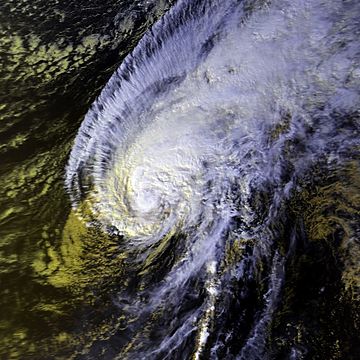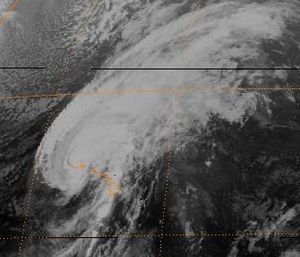Hurricane Iwa facts for kids
| Category 1 hurricane (SSHWS/NWS) | |

Hurricane Iwa satellite image.
|
|
| Formed | November 19, 1982 |
|---|---|
| Dissipated | November 25, 1982 |
| Highest winds | 1-minute sustained: 90 mph (150 km/h) |
| Lowest pressure | 968 mbar (hPa); 28.59 inHg |
| Fatalities | 4 |
| Damage | $312 million (1982 USD) |
| Areas affected | Hawaiʻi |
| Part of the 1982 Pacific hurricane season | |
Hurricane Iwa was a powerful storm that hit Hawaiʻi in 1982. Its name, Iwa, comes from the Hawaiian language word for the frigatebird, which means "Thief." At the time, it was the most expensive hurricane to ever affect the state. Iwa was the last hurricane of the 1982 Pacific hurricane season.
The storm started as a low-pressure area near the equator on November 19. It slowly grew stronger and became a hurricane on November 23. Hurricane Iwa then sped up and passed very close to the island of Kauaʻi with strong winds up to 90 mph (145 km/h). The next day, it moved away from Hawaii and lost its hurricane strength.
Hurricane Iwa caused a lot of damage to the islands of Niʻihau, Kauaʻi, and Oʻahu. Wind gusts reached over 100 mph (160 km/h), and ocean waves were taller than 30 feet (9 m). This was the first major hurricane to hit the Hawaiian Islands since Hawaii became a state in 1959. The storm badly damaged or destroyed 2,345 buildings, including 1,927 homes. About 500 people lost their homes. The total damage across the state was around $312 million in 1982. Sadly, one person died directly because of the high waves, and three others passed away due to issues that happened after the hurricane.
Contents
How Hurricane Iwa Formed and Grew
In the middle of November, a large area of low pressure formed near the equator. This area had strong winds and many thunderstorms. On November 18, a storm system began to organize near Palmyra Atoll and slowly moved west.
Even though it was late in the hurricane season, the ocean waters south of Hawaii were very warm. This was because of a strong El Niño event that year. These warm waters helped the storm grow into Tropical Storm Iwa on November 19. It was about 970 miles (1,760 km) southwest of the southern tip of Hawaii.
The storm first moved slowly north and stayed a weak tropical storm. Then, it turned northeast and started to get stronger. On November 23, it turned north-northwest and became a hurricane. At this point, it was 580 miles (930 km) southwest of Hawaii.
Soon after becoming a hurricane, Iwa turned and sped up towards the northeast. It had enough moisture and energy to keep getting stronger. Late on November 23, Hurricane Iwa reached its strongest winds of 90 mph (145 km/h). It was then 245 miles (395 km) southwest of Waimea on Kauaʻi. The hurricane moved very fast, between 30 and 40 mph. It passed just north of Kauaʻi on November 23 (which was November 24 in UTC time). The strongest part of the storm, with gusts from 100 to 120 mph (161 to 193 km/h), stretched across Kauaʻi and Oʻahu. After passing Hawaii, Iwa quickly weakened and lost its hurricane features. By November 25, it was no longer a tropical storm.
Hurricane Iwa's Impact on Hawaii
Hurricane Iwa brought very strong wind gusts, up to 120 mph (193 km/h), to Kauaʻi and Oʻahu. Because the hurricane moved so fast, its powerful waves and storm surge hit the Hawaiian Islands hard, especially near its path. The storm surge, which is when sea levels rise above normal, reached about eight feet (two meters) on the south coast of Kauaʻi. This surge pushed water inland for about 900 feet (275 m). The heaviest rain recorded was over 20 inches (516 mm) at one location. Waves on Oʻahu's coast reached 16.4 feet (3 m), and on southern Kauaʻi, they were over 30 feet (9 m) high.

During the worst of the storm, about 5,800 people living near the coast of Kauaʻi had to move to safe shelters. The powerful waves sank or stranded many small boats on Kauaʻi's southwestern coast. At Port Allen, 44 out of 45 boats were sunk. The worst damage happened in Poipu, where the huge waves destroyed or badly damaged many fancy hotels and condos. Other areas on the island that didn't have a protective coral reef also saw a lot of damage.
Strong winds damaged several small planes at Lihue airport, overturning many of them. The winds also destroyed many buildings across the island, including an old church and a warehouse. The roof of a bank was also ripped off. At first, the entire island of Kauaʻi lost all power. Roads were blocked by fallen telephone poles, making it hard for people to get around. Rising waters also washed out several roads near the coast. The strong winds destroyed almost all papaya and banyan trees on the island. In total, 1,907 homes on Kauaʻi were destroyed or badly damaged, and 2,983 others had minor damage. This meant one-eighth of the island's homes were not livable.
On Oʻahu, the damage from wind and waves was worst on the southwest coast. The storm surge washed sand onto streets in Waikīkī and flooded cars in underground parking garages. Winds were strongest where they blew off the mountains from the south. Several small planes and a Douglas DC-3 plane were damaged in Honolulu. Gusty winds shattered glass windows at Honolulu International Airport, hurting several passengers. Some flights were delayed, and other airports were temporarily closed. On Oʻahu, at least 6,391 homes, 21 hotels, and two condo buildings were damaged. Also, 418 buildings, including 30 businesses, were destroyed.
Waves caused damage across all the Hawaiian islands. About 120 people were treated for injuries, but most were not serious. Around 500 people across Hawaii lost their homes because of the hurricane. The private island of Niʻihau also suffered severe damage. An aerial survey showed that 20 homes were destroyed and 160 were damaged. This meant almost all of the island's 226 residents were affected. Luckily, no one was reported injured on Niʻihau. At the time, Hurricane Iwa was the most expensive storm to hit Hawaii.
Aftermath and Recovery Efforts
Three days after Hurricane Iwa passed, Hawaii's Governor, George Ariyoshi, declared Kauaʻi and Niʻihau disaster areas. He started the process to get federal help. Five days after the hurricane, President Ronald Reagan declared Kauaʻi, Niʻihau, and Oʻahu disaster areas. This meant federal money would be available to help the affected people. The state's Department of Education decided to close all schools on Kauaʻi for an unknown time.
Thousands of residents without power celebrated Thanksgiving by cooking turkeys on outdoor grills. The Army and Air Force sent 20,000 Thanksgiving meals to the people in temporary shelters. The military also flew generators to Kauaʻi because of the long power outages. About three weeks after the hurricane, power was back on in most major areas of Oʻahu. However, 5,000 people on Kauaʻi were still without power. About a month after the storm, most of Kauaʻi had its power back. All roads and highways were also cleared. Sadly, one soldier died while helping with cleanup after the hurricane. Two people also died in a car accident because traffic lights were not working.
After the storm, a lot of rebuilding happened in Poipu, where the hurricane had flooded areas far inland. Ten years later, Hurricane Iniki hit the same area. Officials believe that if a hurricane like Iwa hit Oʻahu today, it could cause up to $7.5 billion in damage.
Retirement of the Name Iwa
The Central Pacific Hurricane Center decided to stop using the name Iwa after this storm because of the severe damage it caused. This is a common practice for very destructive hurricanes. The name was replaced with Io. However, in 2007, the Center updated its lists of tropical cyclone names and changed Io to Iona before it was ever used. Iwa was the first hurricane name to be retired in the Central Pacific since they started using Hawaiian names in the early 1980s. It is still one of only four names retired in that region as of 2015.
Images for kids


